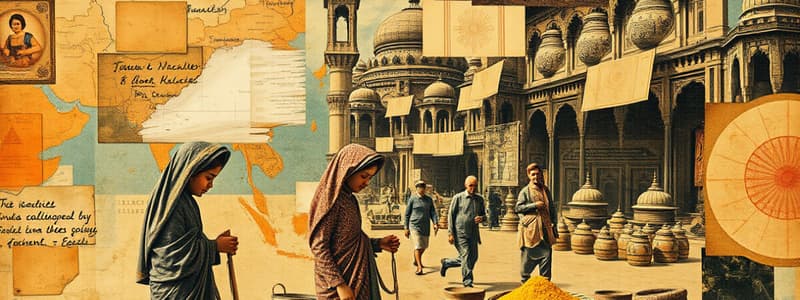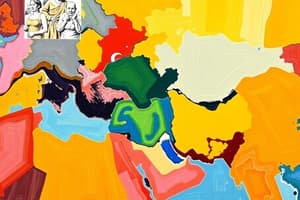Podcast
Questions and Answers
India’s centuries-old trade with the West consisted mainly of spices, textiles, sugar, indigo and ______.
India’s centuries-old trade with the West consisted mainly of spices, textiles, sugar, indigo and ______.
saltpetre
The Arabs, who controlled this trade, took these goods from India to the ports on the Persian Gulf and the ______.
The Arabs, who controlled this trade, took these goods from India to the ports on the Persian Gulf and the ______.
Red Sea
The rise of the ______ in West Asia in 1453 disrupted this well-established trade route.
The rise of the ______ in West Asia in 1453 disrupted this well-established trade route.
Turks
Vasco da Gama sailed around the Cape of Good Hope and landed at ______, on the west coast of India, in 1498.
Vasco da Gama sailed around the Cape of Good Hope and landed at ______, on the west coast of India, in 1498.
The Mughal emperors did not consider the Europeans a ______ to the empire.
The Mughal emperors did not consider the Europeans a ______ to the empire.
The Portuguese were the first to set up a ______ company in India.
The Portuguese were the first to set up a ______ company in India.
Vasco da Gama was the first Portuguese traveller to reach India by ______.
Vasco da Gama was the first Portuguese traveller to reach India by ______.
The Portuguese were able to monopolise Indian trade with Europe through the ______ century.
The Portuguese were able to monopolise Indian trade with Europe through the ______ century.
Vasco da Gama befriended the neighbouring ruler of ______.
Vasco da Gama befriended the neighbouring ruler of ______.
In 1510, Albuquerque captured ______ from the Sultan of Bijapur.
In 1510, Albuquerque captured ______ from the Sultan of Bijapur.
The Portuguese acquired ______ near Madras.
The Portuguese acquired ______ near Madras.
The Dutch established several trading centres, including Surat and ______.
The Dutch established several trading centres, including Surat and ______.
The English East India Company was founded in ______.
The English East India Company was founded in ______.
Sir Thomas Roe was sent as an ambassador to the court of ______.
Sir Thomas Roe was sent as an ambassador to the court of ______.
The British built a fortified factory known as Fort ______ in Madras.
The British built a fortified factory known as Fort ______ in Madras.
The French established a fortified trading centre at ______.
The French established a fortified trading centre at ______.
Bombay was given to the British as a gift when Catherine of Braganza married King ______.
Bombay was given to the British as a gift when Catherine of Braganza married King ______.
The island of Bombay is made up of seven ______.
The island of Bombay is made up of seven ______.
Flashcards are hidden until you start studying
Study Notes
Indian Trade with the West
- Centuries-old trade between India and the West primarily involved spices, textiles, sugar, indigo, and saltpetre.
- The Arab traders controlled the trade routes, transporting goods from Indian ports to the Persian Gulf and Red Sea before overland delivery to Europe.
- The rise of the Turks in West Asia in 1453 disrupted established trade routes, prompting European nations to seek sea routes to India.
European Exploration and Arrival
- Vasco da Gama, in 1498, became the first European explorer to reach India, landing in Calicut after sailing around the Cape of Good Hope.
- His discovery established a direct sea route to India, attracting other European powers like the Dutch, British, and French for trade.
- Mughal emperors did not initially view Europeans as threats, allowing them to establish small trading settlements.
Decline of Mughal Power
- By the 18th century, regional powers in India began asserting independence, leading to changing dynamics in trade and power.
- European trading companies started to ally with local rulers, increasing their own power at the cost of the Mughal Empire.
The Portuguese in India
- The Portuguese were the first Europeans to set up a trading company in India, dominating trade in the 16th century due to their strong navy.
- Vasco da Gama established friendly relations with local rulers, and Albuquerque captured Goa in 1510, using it as headquarters.
- By the late 16th century, Portuguese power declined due to weak leadership and competition from Dutch and British companies.
The Dutch East India Company
- Founded in 1602, the Dutch East India Company emerged as a strong trading power in the 17th century.
- The Dutch broke the Portuguese monopoly in the Indian Ocean and established key trading centres but later focused on settlements in Southeast Asia.
- The British capitalized on the Dutch's weakened position, gradually diminishing their influence in India.
The British East India Company
- Founded in 1600, the English East India Company received a royal charter from Queen Elizabeth I to trade with India.
- In 1615, the British secured permission from Mughal Emperor Jahangir to establish a factory in Surat.
- Gradually expanded, the British created fortified factories, notably building Fort St. George in Madras and expanding into Bengal and Bombay.
Transformation from Traders to Rulers
- British officials initially focused on trade but shifted towards political control under Chairman Sir Josiah Child, who aimed to establish an empire in India.
- After a failed attempt to capture Chittagong, the Company faced setbacks but gained significant rights to trade and collect taxes from Mughal authorities.
- The growth of cities like Calcutta, Madras, and Bombay attracted Indian merchants, leading to British dominance in India.
French Presence in India
- The French East India Company, established in 1664, differed from the English version as it was state-controlled rather than privately owned.
- The French established fortified trading posts in Pondicherry and later expanded to Chandernagore and Mahe.
Acquisition of Bombay
- Bombay, originally consisting of seven islands, was acquired by the Portuguese through the Treaty of Bassein.
- The British received Bombay as a dowry when Catherine of Braganza married King Charles II, who transferred it to the English East India Company in 1668.
Studying That Suits You
Use AI to generate personalized quizzes and flashcards to suit your learning preferences.




